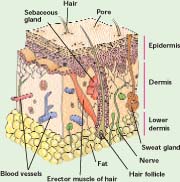What is skin?
The skin is the body's largest and most visible organ. It has several important functions such as protecting the internal organs and regulating the body's temperature. Skin also acts as an indicator for how your body is doing. Your skin's appearance reveals how you feel and if you are taking care of yourself.

+ Because the skin is the body's most visible organ, it is a clear indicator of your health and well-being. Radiant, glowing skin makes us feel confident and beautiful. This organ deserves special attention, it's important to take care of it and to protect the skin during different stages of our lives. The skin's thickness ranges between 1.5 to 4 millimeters, depending on the different parts of the body. The entire skin's surface is sensitive to heat, light and touch, the inner layers of the skin are filled with nerve endings and blood vessels. Healthy skin is an essential part of our health and natural beauty. Good skin is a reflection of inner health. The secret is to understand how your skin functions, and to take care of it properly.
FUNCTIONS OF THE SKIN
∎ It provides a protective barrier, defending the body from all outside environmental influences, including extremes in temperature and exposure to disease organisms such as harmful bacteria and infections, wind and ultraviolet rays from sunshine.
∎ It acts as a thermostat, retaining heat when it's cold, shivering helps to warm up the body and its blood vessels contract to prevent the blood from cooling down. However, when it's hot, the blood flow in the capillaries increases and the sweat glands produce the sweat that refreshes the skin's surface.
∎ The dermis, under the effect of solar rays produces vitamin D, a nutrient essential for the body to absorb and fix calcium in the bones.
∎ The nerve receptors in the skin allow the brain to feel a number of senses such as heat, pain and pleasure.
∎ Sweat released through the skin contains chemical substances called pheromones that stimulate sexual attraction.
STRUCTURE OF THE SKIN
The epidermis is the top layer of the skin that protects your body from invasion and infection. It's built up of several layers of living cells that are then topped by sheets of dead cells. Its outer layer is formed by cells containing keratin, that are worn off daily. In the bottom layer there are other types of cells, the melanophages, that produce the melanin that protects the skin against ultraviolet rays. These cells give the skin its color. The dermis contains a complex of thousands of sweat glands, sebum glands, blood vessels, muscle tissue, nervous fibers, adipose cells, hairs and hair follicles. These are held together by a tough connective tissue called collagen. Collagen is very important in determining the health of the skin. The relative health of collagen determines the contour of the skin, how wrinkled and lined it is.
HOW SKIN WORKS
The skin has two main layers: the epidermis (the outer, impermeable) and the dermis (the inner layer). At the bottom of the epidermis, new skin cells are forming. When the cells are ready, they start moving toward the top of your epidermis. As newer cells continue to move up, older cells near the top die and rise to the surface of your skin. These dead cells eventually flake away when we bath, get dressed or touch, etc. We lose millions of dead cells per day, but living cells constantly replace them.


Comment about this article, ask questions, or add new information about this topic: